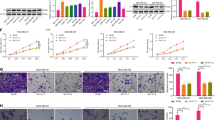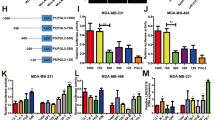Abstract
Breast cancer is ranked as the second leading cause of cancer-related deaths among women. Accumulating evidences have revealed that long non-coding RNAs (lncRNAs) are involved in human tumorigenesis owing to the regulation of essential pathways for tumor initiation and progression. Herein, the current study aimed to explore the regulatory mechanism of lncRNA ZFHX4-AS1 in breast cancer in relation to the Hippo signaling pathway. Initially, microarray analysis was conducted to screen out differentially expressed lncRNAs related to breast cancer. Next, the functional role of lncRNA ZFHX4-AS1 in breast cancer was determined using ectopic expression, knockdown, and reporter assay experiments. Subsequently, lncRNA ZFHX4-AS1, TAF4, TAZ, and YAP expressions were determined, followed by verification of the targeting relationship between lncRNA ZFHX4-AS1 and TAF4. Then cell proliferation, invasion, migration, cell cycle, and apoptosis were measured. Lastly, tumor growth and metastasis were detected by tumor xenograft in nude mice. LncRNA ZFHX4-AS1 was found to be highly expressed while FAT4 was poorly expressed in breast cancer tissues. FAT4 was the target gene of lncRNA ZFHX4-AS1, and lncRNA ZFHX4-AS1 silencing increased FAT4 expressions, while decreased YAP and TAZ expressions. In addition, knockdown of lncRNA ZFHX4-AS1 suppressed breast cancer cell proliferation, migration, and invasion as well as tumor growth, blocked cell cycle entry, while promoted cell apoptosis by inhibiting the Hippo signaling pathway. In conclusion, our findings reveal that lncRNA ZFHX4-AS1 silencing exerts an inhibitory effect on breast cancer development by suppressing the activation of the Hippo signaling pathway via FAT4.
This is a preview of subscription content, access via your institution
Access options
Subscribe to this journal
Receive 12 print issues and online access
$259.00 per year
only $21.58 per issue
Buy this article
- Purchase on Springer Link
- Instant access to full article PDF
Prices may be subject to local taxes which are calculated during checkout










Similar content being viewed by others
References
Lee SY, Seo JH. Current strategies of endocrine therapy in elderly patients with breast cancer. Biomed Res Int. 2018;2018:6074808.
Sun J, Cui H, Gao Y, Pan Y, Zhou K, Huang J, et al. TGF-alpha overexpression in breast cancer bone metastasis and primary lesions and TGF-alpha enhancement of expression of procancer metastasis cytokines in bone marrow mesenchymal stem cells. Biomed Res Int. 2018;2018:6565393.
He K, Wang P. Unregulated long non-coding RNA-AK058003 promotes the proliferation, invasion and metastasis of breast cancer by regulating the expression levels of the gamma-synuclein gene. Exp Ther Med. 2015;9:1727–32.
You MK, Kim HJ, Kook JH, Kim HA. St. John’s Wort regulates proliferation and apoptosis in MCF-7 human breast cancer cells by inhibiting AMPK/mTOR and activating the mitochondrial pathway. Int J Mol Sci. 2018;19:pii:E966.
Quan H, Liang M, Li N, Dou C, Liu C, Bai Y, et al. LncRNA-AK131850 Sponges MiR-93-5p in newborn and mature osteoclasts to enhance the secretion of vascular endothelial growth factor a promoting vasculogenesis of endothelial progenitor cells. Cell Physiol Biochem. 2018;46:401–17.
Luo X, Shi Q, Gu Y, Pan J, Hua M, Liu M, et al. LncRNA pathway involved in premature preterm rupture of membrane (PPROM): an epigenomic approach to study the pathogenesis of reproductive disorders. PLoS ONE. 2013;8:e79897.
Wang H, Niu L, Jiang S, Zhai J, Wang P, Kong F, et al. Comprehensive analysis of aberrantly expressed profiles of lncRNAs and miRNAs with associated ceRNA network in muscle-invasive bladder cancer. Oncotarget. 2016;7:86174–85.
Ma L, Cui J, Xi H, Bian S, Wei B, Chen L. Fat4 suppression induces Yap translocation accounting for the promoted proliferation and migration of gastric cancer cells. Cancer Biol Ther. 2016;17:36–47.
Qi C, Zhu YT, Hu L, Zhu YJ. Identification of Fat4 as a candidate tumor suppressor gene in breast cancers. Int J Cancer. 2009;124:793–8.
Azad T, Janse van Rensburg HJ, Lightbody ED, Neveu B, Champagne A, Ghaffari A, et al. A LATS biosensor screen identifies VEGFR as a regulator of the Hippo pathway in angiogenesis. Nat Commun. 2018;9:1061.
Zhou W, Zhao M. How Hippo signaling pathway modulates cardiovascular development and diseases. J Immunol Res. 2018;2018:3696914.
Gokey JJ, Sridharan A, Xu Y, Green J, Carraro G, Stripp BR, et al. Active epithelial Hippo signaling in idiopathic pulmonary fibrosis. JCI Insight. 2018;3:98738.
Shi P, Feng J, Chen C. Hippo pathway in mammary gland development and breast cancer. Acta Biochim Biophys Sin (Shanghai). 2015;47:53–59.
Xu Y, Lin X, Xu J, Jing H, Qin Y, Li Y. SULT1E1 inhibits cell proliferation and invasion by activating PPARgamma in breast cancer. J Cancer. 2018;9:1078–87.
Hu S, Chang J, Li Y, Wang W, Guo M, Zou EC, et al. Long non-coding RNA XIST as a potential prognostic biomarker in human cancers: a meta-analysis. Oncotarget. 2018;9:13911–9.
Zhao W, Geng D, Li S, Chen Z, Sun M. LncRNA HOTAIR influences cell growth, migration, invasion, and apoptosis via the miR-20a-5p/HMGA2 axis in breast cancer. Cancer Med. 2018;7:842–55.
Yang T, Li S, Liu J, Yin D, Yang X, Tang Q. lncRNA-NKILA/NF-kappaB feedback loop modulates laryngeal cancer cell proliferation, invasion, and radioresistance. Cancer Med. 2018;7:2048–63.
Jiang X, Liu Z, Xia Y, Luo J, Xu J, He X, et al. Low FAT4 expression is associated with a poor prognosis in gastric cancer patients. Oncotarget. 2018;9:5137–54.
Cai J, Feng D, Hu L, Chen H, Yang G, Cai Q, et al. FAT4 functions as a tumour suppressor in gastric cancer by modulating Wnt/beta-catenin signalling. Br J Cancer. 2015;113:1720–9.
Hou L, Chen M, Zhao X, Li J, Deng S, Hu J et al. FAT4 functions as a tumor suppressor in triple-negative breast cancer. Tumour Biol. 2016;37:16337–43.
Ito T, Taniguchi H, Fukagai K, Okamuro S, Kobayashi A. Inhibitory mechanism of FAT4 gene expression in response to actin dynamics during Src-induced carcinogenesis. PLoS ONE. 2015;10:e0118336.
Cho SY, Gwak JW, Shin YC, Moon D, Ahn J, Sol HW, et al. Expression of Hippo pathway genes and their clinical significance in colon adenocarcinoma. Oncol Lett. 2018;15:4926–36.
Shen J, Cao B, Wang Y, Ma C, Zeng Z, Liu L, et al. Hippo component YAP promotes focal adhesion and tumour aggressiveness via transcriptionally activating THBS1/FAK signalling in breast cancer. J Exp Clin Cancer Res. 2018;37:175.
Wei C, Wang Y, Li X. The role of Hippo signal pathway in breast cancer metastasis. Onco Targets Ther. 2018;11:2185–93.
Ruan T, He X, Yu J, Hang Z. MicroRNA-186 targets Yes-associated protein 1 to inhibit Hippo signaling and tumorigenesis in hepatocellular carcinoma. Oncol Lett. 2016;11:2941–5.
Dong L, Lin F, Wu W, Liu Y, Huang W. Verteporfin inhibits YAP-induced bladder cancer cell growth and invasion via Hippo signaling pathway. Int J Med Sci. 2018;15:645–52.
Acknowledgements
We would like to give our sincere appreciation to the reviewers for their helpful comments on this article.
Authors’ contributions
S-YL and HW designed the study. S-YL, HW, H-FM, G-FL., and S-JC collated the data, designed, and developed the database, carried out data analyses, and produced the initial draft of the manuscript. H-FM, S-JC, G-SL, and B-CL contributed to drafting the manuscript. All authors participated in editing and revising the manuscript and have read and approved the final submitted manuscript.
Author information
Authors and Affiliations
Corresponding author
Ethics declarations
Conflict of interest
The authors declare that they have no conflict of interest.
Ethical statement
Collection of specimens and clinical data were approved by the Moral and Ethical Committee of Baoan Maternal and Child Health Hospital, Jinan University, Sanming Project of Medicine in Shenzhen. Signed informed consents were obtained from all patients and their families before collecting the specimens. All animal experiments were in line with the social guidelines of the China Animal Ethics Committee, and all efforts were made to minimize the suffering of the included animals.
Rights and permissions
About this article
Cite this article
Li, SY., Wang, H., Mai, HF. et al. Down-regulated long non-coding RNA RNAZFHX4-AS1 suppresses invasion and migration of breast cancer cells via FAT4-dependent Hippo signaling pathway. Cancer Gene Ther 26, 374–387 (2019). https://doi.org/10.1038/s41417-018-0066-6
Received:
Revised:
Accepted:
Published:
Issue Date:
DOI: https://doi.org/10.1038/s41417-018-0066-6
This article is cited by
-
A hypoxia–glycolysis–lactate-related gene signature for prognosis prediction in hepatocellular carcinoma
BMC Medical Genomics (2024)
-
FAT4 activation inhibits epithelial-mesenchymal transition (EMT) by promoting autophagy in H2228/Cer cells
Medical Oncology (2022)
-
Differential expression profiles of long noncoding RNAs and mRNAs in human bone marrow mesenchymal stem cells after exposure to a high dosage of dexamethasone
Stem Cell Research & Therapy (2021)
-
Bioinformatics analysis of long non-coding RNA-associated competing endogenous RNA network in schizophrenia
Scientific Reports (2021)
-
Coding the noncoding: 2 years of advances in the field of microRNAs and long noncoding RNAs
Cancer Gene Therapy (2021)



